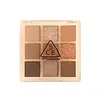What's inside
What's inside
 Key Ingredients
Key Ingredients

 Benefits
Benefits

 Concerns
Concerns

 Ingredients Side-by-side
Ingredients Side-by-side

Talc
AbrasiveAluminum Starch Octenylsuccinate
AbsorbentMica
Cosmetic ColorantSynthetic Fluorphlogopite
Caprylic/Capric Triglyceride
MaskingMagnesium Myristate
CI 77891
Cosmetic ColorantCI 77492
Cosmetic ColorantDiisostearyl Malate
EmollientMethylpropanediol
SolventMagnesium Stearate
Cosmetic ColorantPropanediol
SolventDimethicone
EmollientTriethoxycaprylylsilane
Aluminum Hydroxide
EmollientWater
Skin ConditioningCI 77491
Cosmetic ColorantCI 77499
Cosmetic ColorantCI 77742
Cosmetic ColorantBis-Diglyceryl Polyacyladipate-2
EmollientCalcium Sodium Borosilicate
Polyglyceryl-2 Triisostearate
EmulsifyingCI 19140
Cosmetic ColorantCI 77007
Cosmetic ColorantGlass
AbrasiveCI 73360
Cosmetic ColorantPolybutylene Terephthalate
Acrylates Copolymer
Ethylene/Va Copolymer
Emulsion StabilisingSilica
AbrasiveCI 15985
Cosmetic ColorantCI 75470
Cosmetic ColorantDimethiconol Stearate
EmollientOctyldodecyl Stearoyl Stearate
EmollientCalcium Aluminum Borosilicate
Nylon-12
Phenyl Trimethicone
Skin ConditioningTriethylhexanoin
MaskingDipentaerythrityl Hexahydroxystearate/Hexastearate/Hexarosinate
Skin ConditioningSorbitan Sesquiisostearate
EmulsifyingMethyl Methacrylate Crosspolymer
Talc, Aluminum Starch Octenylsuccinate, Mica, Synthetic Fluorphlogopite, Caprylic/Capric Triglyceride, Magnesium Myristate, CI 77891, CI 77492, Diisostearyl Malate, Methylpropanediol, Magnesium Stearate, Propanediol, Dimethicone, Triethoxycaprylylsilane, Aluminum Hydroxide, Water, CI 77491, CI 77499, CI 77742, Bis-Diglyceryl Polyacyladipate-2, Calcium Sodium Borosilicate, Polyglyceryl-2 Triisostearate, CI 19140, CI 77007, Glass, CI 73360, Polybutylene Terephthalate, Acrylates Copolymer, Ethylene/Va Copolymer, Silica, CI 15985, CI 75470, Dimethiconol Stearate, Octyldodecyl Stearoyl Stearate, Calcium Aluminum Borosilicate, Nylon-12, Phenyl Trimethicone, Triethylhexanoin, Dipentaerythrityl Hexahydroxystearate/Hexastearate/Hexarosinate, Sorbitan Sesquiisostearate, Methyl Methacrylate Crosspolymer
 Reviews
Reviews

Ingredients Explained
These ingredients are found in both products.
Ingredients higher up in an ingredient list are typically present in a larger amount.
Calcium Sodium Borosilicate is a bulking agent. It is considered a borosilicate glass; it is composed of powder or flakes of calcium and sodium borosilicates.
This ingredient is used to add volume, shine, and color to products. You'll most likely find this ingredient in makeup products.
According to in-vivo and ex-vivo studies done by a manufacturer, this ingredient works well with UV filters:
Learn more about Calcium Sodium BorosilicateCi 77891 is a white pigment from Titanium dioxide. It is naturally found in minerals such as rutile and ilmenite.
It's main function is to add a white color to cosmetics. It can also be mixed with other colors to create different shades.
Ci 77891 is commonly found in sunscreens due to its ability to block UV rays.
Learn more about CI 77891Methylpropanediol is a synthetic solvent and humectant.
As a solvent, it helps dissolve other ingredients, helping to evenly distribute ingredients throughout the product. This ingredient has also been shown to have antimicrobial properties which makes it a preservative booster.
Methylpropanediol is able to add a bit of moisture to the skin. It also helps other ingredients be better absorbed into the skin, such as salicylic acid.
Learn more about MethylpropanediolMica is a naturally occurring mineral used to add shimmer and color in cosmetics. It can also help improve the texture of a product or give it an opaque, white/silver color.
Serecite is the name for very fine but ragged grains of mica.
This ingredient is often coated with metal oxides like titanium dioxide. Trace amounts of heavy metals may be found in mica, but these metals are not harmful in our personal products.
Mica has been used since prehistoric times throughout the world. Ancient Egyptian, Indian, Greek, Roman, Aztec, and Chinese civilizations have used mica.
Learn more about MicaSilica, also known as silicon dioxide, is a naturally occurring mineral. It is used as a fine, spherical, and porous powder in cosmetics.
Though it has exfoliant properties, the function of silica varies depending on the product.
The unique structure of silica enhances the spreadability and adds smoothness, making it a great texture enhancer.
It is also used as an active carrier, emulsifier, and mattifier due to its ability to absorb excess oil.
In some products, tiny microneedles called spicules are made from silica or hydrolyzed sponge. When you rub them in, they lightly polish away dead skin layers and enhance the penetration of active ingredients.
Learn more about SilicaWater. It's the most common cosmetic ingredient of all. You'll usually see it at the top of ingredient lists, meaning that it makes up the largest part of the product.
So why is it so popular? Water most often acts as a solvent - this means that it helps dissolve other ingredients into the formulation.
You'll also recognize water as that liquid we all need to stay alive. If you see this, drink a glass of water. Stay hydrated!
Learn more about Water